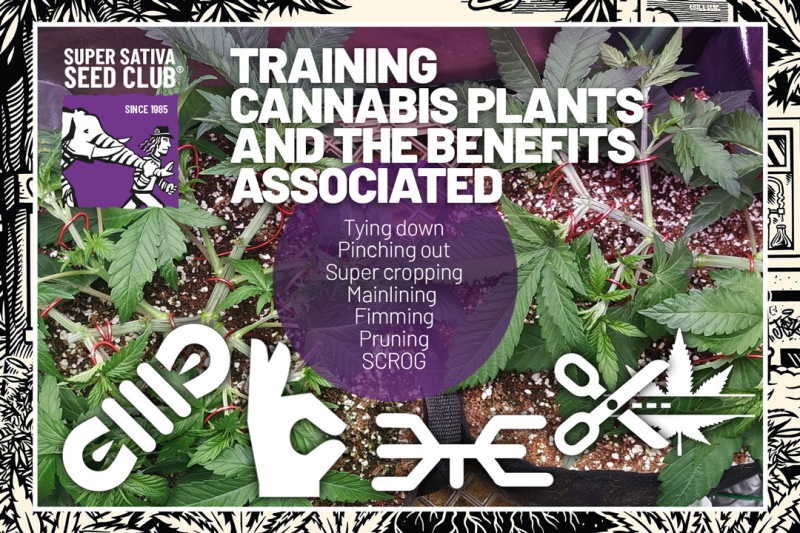
Training Cannabis plants is a great way to increase yields, reduce height, manipulate the shape and growth structure of your garden. There are many different styles and methods of training, with some being easier than others, each with their own advantages. In this article we explain all about training Cannabis plants, the 7 different techniques, mistakes to avoid and more.
What does plant training mean?
Basically training Cannabis plants allows you to affect the way that the plants grow, allowing a grower to be hands-on, and in control of the hormones the plants naturally produce. Most growers will train plants to increase yield, however not all plants will react the same way to training as others, so finding out what methods work best, with which cultivars is a learning experience. Training Cannabis plants should be performed during the vegetative state, and avoided once flowering has started.
The benefits of training Cannabis plants
● There will be an increase in production and yield capability.
● Plant height can be significantly reduced with plant training.
● Training Cannabis plants costs nothing and a small amount of labor.
● A grower can manipulate auxin and other growth hormones produced.
● The structure of a plant will become much stronger and sturdy.
● Plant training is a great way to grow one enormous plant.
The different styles of training Cannabis plants
Before discussing the actual different techniques that can be applied when training Cannabis plants, it is important to know there is a low stress and high stress version. Depending on your skill and experience, learning the low stress techniques can be the best starting point for a beginner grower.
Low stress: This refers to techniques that are not as traumatic to the plants, Low stress types of training will allow the plants to recover quickly and do not inflict too much trauma in one sitting.
High stress: This will refer to the more brutal side of things, where the plants will require a longer recovery time. High stress training will cover such techniques as snapping stems, mainlining and heavy pruning.
What about recovery time?
When training Cannabis plants, it is extremely important the plants are allowed time to fully recover and resume growing. Not allowing plants to heal in time and then being forced to undergo more training, may do the plants more harm than good, so it is best to allow the plants 3–5 days between training techniques to be applied and 7 days or longer when breaking stems.
The 7 different ways of training Cannabis plants
1. Tying down
Using gardening wire or string, tying plants down allows you to change the canopy structure and to cause the primary crown shoot to be lowered. As a result, the side branches will attempt to take its place and become the dominant crown shoot. Once the tied down part begins to grow upwards, the shape and structure will not have changed into a bushy and round plant.
2. Pinching out
A very simple method that can be done by hand, however, is always best to perform with a sharp and clean pair of scissors. Topping, or pinching out, involved totally removing the top growth site, exposing the two small axillary shoots. The growth hormone named auxin, responsible for apical dominance and height, becomes disrupted, allowing the plants to produce two crown tops and significantly reduce height.
3. Super cropping
Another name for snapping stems, which is classed as a high stress technique, and should only be performed when the plants are mature and strong enough. Squeezing and twisting the stems of the plants to break the inner cell walls is advantageous when training Cannabis plants as this method produces sturdy, thick branches with extra support where the break originally occurred and signals for the plants to produce growth hormone to repair each break.
4. Mainlining
A method of growing Cannabis which takes quite a lot of time in terms of preparation, and involves using many techniques at once. Mainlining is a great way to turn a few plants into massive producers, however is best suited for the more experienced growers who can afford to extensively train their plants for a long period of time. The way mainlining works is to use
topping, tying down and pruning together to create a symmetrical shape and structure and can take months before being ready to flower. It is important to know this style of growing cannot be done with autoflowering genetics.
5. Fimming
Another way to temporarily stop the plants from growing tall, and to allow them to focus on the side branches and lower canopy, is a technique called fimming. An old school name that originated from ‘ flip I missed ’ and meant that your attempt at pinching out was unsuccessful. The way fimming works is to leave behind 25% of the top shoot. So unlike a clean cut topping / pinching out, you will have enough of the top part remaining that when growth resumes back to normal, the plants still have one main crown shoot and not two.
6. Pruning
When training Cannabis plants, pruning can determine how the plants will use their energy, and the final size and quality of the buds growing. Pruning has also been referred to as lollipopping, and should be performed with a sharp scalpel to achieve the cleanest cuts possible. Many growers have their own way of pruning, and if pruning late, you should avoid pruning once the plants are producing buds. Removing a large amount of foliage at once is best done before changing the timers to 12/12.
7. SCROG
If you have heard of SOG before, then you may also be familiar with SCROG. Meaning a screen of green, or a net frame that sits over plants, similar to mainlining, extensively training Cannabis plants through a screen, then pruning everything underneath can take months of work and dedication. One of the biggest benefits of using a screen is for growers with a small plant count, massive yielding plants are easily possible.
Mistakes to avoid when training Cannabis plants
● Inflicting too much trauma without allowing plants to fully recover.
● Tearing off the foliage rather than using a sharp scalpel for a clean cut.
● Training Cannabis plants when they are too young and weak.
● Using blunt scissors or scalpel when topping and pruning plants.
● Pruning late into flowering and causing plants to stress out.
Conclusion
Training Cannabis plants is a cheap and effective way of boosting your yields overnight, and allowing you to learn what techniques work best with which strains. It does not matter if you are a beginner or expert grower, there are many ways you can grow Cannabis indoors and each grower has their own preferred method and style. We recommend you learn more about the techniques covered in this article, and good luck taking your yields to the next level!
(740) (0)

